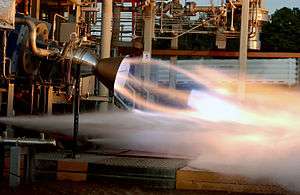RS-88
The RS-88 is a liquid-fueled rocket engine burning ethanol as fuel, and using liquid oxygen (LOX) as the oxidizer. It was designed and built by Rocketdyne, originally for the NASA Bantam System Technology program (1997).
 An RS-88 is fired at Stennis Space Center | |
| Country of origin | United States |
|---|---|
| Manufacturer | Aerojet Rocketdyne |
| Application | Developed into an abort motor for the CST-100 Starliner |
| Status | Active |
| Liquid-fuel engine | |
| Propellant | Liquid oxygen / Ethanol or MMH / NTO (LAE variant) |
| Performance | |
| Thrust | 220kN (ethanol) or 176.6kN (hypergolic) |
| Used in | |
| CST-100 Starliner | |
In 2003, it was designated by Lockheed for their pad abort demonstration (PAD) vehicle. NASA tested the RS-88 in a series of 14 hot-fire tests, resulting in 55 seconds of successful engine operation in November and December 2003. The RS-88 engine proved to be capable of 50,000 lbf (220 kN) of thrust at sea level.
A hypogolic derivative of the RS-88 has been selected for the CST-100 launch escape system.[1] This version is capable of 39,700lbf (176.6kN) of thrust and four are used in Starliner's abort system.[2]
Bantam Launch System
The Bantam System Technology Project, which is part of the Low Cost Technologies effort, teams NASA and its business partners to research and demonstrate technologies for a new low-cost launch system. A technology demonstration flight was targeted for late 1999.[3]
The RS-88 engine was designed by Rocketdyne under NASA's Bantam program[4] which was the propulsion element of the low-cost technologies of the larger Advanced Space Transportation Program.
Pad abort demonstration
The RS-88 engine was modified and tested in 2003[5] for application on the Lockheed-Martin pad abort demonstration (PAD) vehicle. Critical design review of the PAD propulsion module occurred in mid-2004, but the planned use of the vehicle in CEV development was evidently abandoned. Lockheed Martin's PAD vehicle was originally scheduled for launch in late 2005 and would have carried four RS-88 engines.
Rocketplane
In January 2006 it was announced that NASA was loaning the RS-88 rocket engine to Rocketplane, of Oklahoma City, as part of an innovative industry partnership program.[6] NASA's Johnson Space Center, Houston, and the company signed a Space Act Agreement for use of an RS-88 engine in tests of its Rocketplane XP vehicle for three years. The company was to provide NASA with design, test and operational information from the development. The Rocketplane XP was a four-seat, modified Lear executive jet. It would have incorporated a rocket engine for acceleration to achieve a planned peak altitude of almost 300,000 feet.
"With NASA, the Federal Aviation Administration, and the support of local, state and federal governments, we hope to develop a safe, affordable and reusable spaceplane by integrating established technologies, such as the RS-88 engine," said Bob Seto, Rocketplane's vice president of engineering systems and analysis. According to Seto, the craft completed a preliminary design review in March 2005, and it was in the detail design phase.
Rocketplane filed for Chapter 7 bankruptcy and liquidation in 2010.[7]
Boeing CST-100

The launch escape system for Boeing's CST-100 spacecraft uses a lightweight, hypergolic derivative of the RS-88 called the Launch Abort Engine (LAE).[8]
See also
- NASA Advanced Space Transportation Program
- CST-100
- Constellation program
- Merlin (rocket engine)
References
- "Test of Rocketdyne abort motor for Boeing crew capsule". youtube.com. Retrieved 24 November 2011.
- Clark, Stephen. "Aerojet Rocketdyne wins propulsion contracts worth nearly $1.4 billion – Spaceflight Now". Retrieved 2019-12-19.
- "Low Cost Technologies" (Press release). NASA. June 1997.
- "NASA Selects Four Companies to Demonstrate Low Cost Launch System Technologies" (Press release). NASA. June 9, 1997. Release C97. Archived from the original on November 20, 2011.
- "Boeing Successfully Tests New Engine for NASA Program" (Press release). Boeing. Jan 29, 2004. Archived from the original on 2012-04-19.
- "NASA Loans Engine to Industry Partner". NASA. Jan 24, 2006.
- "Former Oklahoma Rocketplane's bankruptcy may be last stop on itinerary". NewsOK.com. 8/10/2010. Check date values in:
|date=(help) - "PWR Analyzing Hot-Fire Tests For CST-100 Launch Abort Engine". http://www.beyondearth.com. Archived from the original on 23 September 2015. Retrieved 5 September 2015. External link in
|work=(help)
External links
| Wikimedia Commons has media related to RS-88 (rocket engine). |
